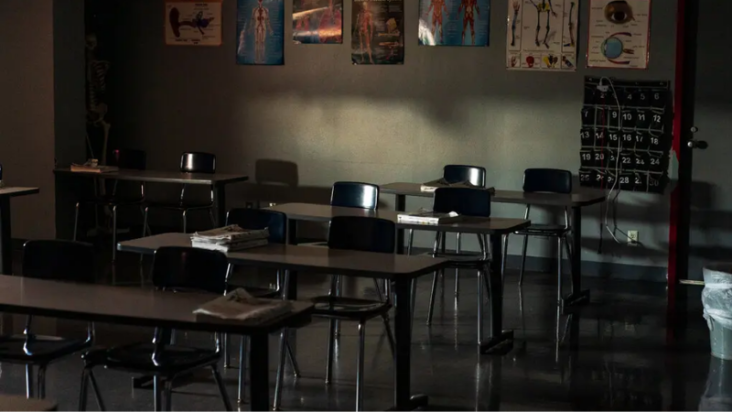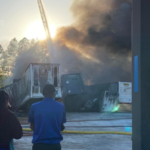
At one middle school, more than 40 percent of the students have been chronically absent this year. Districts are going to great lengths — offering gift cards, night classes — to reach them.
After the coronavirus pandemic pushed his classes online in the spring of 2020, Isaac Mosley, now 18, got used to spending his time outside of school.
Isaac, a public school student in Waco, Texas, finished his sophomore year remotely. During his junior year, he worked at a lumber company, where he discovered that he could still be counted as present at school if he carved out some time to check in online.
When he became a senior last fall, his high school fully resumed in-person learning. But Isaac kept working, earning money to support himself and his family while racking up dozens of missed school days and hundreds of missed classes.
Isaac is one of millions of public school students across the United States who are considered chronically absent — often defined as missing 10 percent of the days in a school year, whether the absences are excused or not.
“Chronic absence has skyrocketed” during the pandemic, said Hedy Chang, the director of Attendance Works, a national group that promotes solutions to chronic absenteeism, which has been linked to weaker academic performance and can predict whether a student is more likely to drop out before finishing high school.

Credit…Ilana Panich-Linsman for The New York Times.
Rates of absenteeism can be hard to compare nationally because schools do not report the data in the same way, nor on the same timetable. But according to a December report from the consulting firm McKinsey & Company, which defined chronic absenteeism as missing 15 school days per year, the percentage of students who were on track to be chronically absent was about 22 percent — more than double the rate of chronically absent students before the pandemic.
“While absenteeism rates for high-income students are leveling off, rates for low-income students have continued to worsen since the spring,” the report added.
“What we know,” Dr. Chang said, “is that chronic absence is exacerbating existing inequities.”
For school districts, attendance is a knotty problem. Showing up to class is fundamental to learning, but schools have little control over absences and solving the problem is not easy. Chronic absenteeism can stem from a variety of issues including instability at home, work obligations or illness.
Now, unsettled by the continuing shock waves of a pandemic, even more students appear to be falling through the cracks. And district employees — stretched increasingly thin by understaffing and absences of their own — are grasping for creative ways to lure students back.
Some are offering night classes. Others are giving gift cards for groceries. At least one has eaten insects.
When McDonough Middle School in Hartford, Conn., held a pep rally to encourage student attendance last month, about 16 percent of the school’s students were marked absent. That meant 51 children missed their chance to see the basketball free-throw contest in the gymnasium and the spirited dance-off between two sixth-grade teachers.

Still, it was not a bad turnout for a district where more than 40 percent of the students have been chronically absent this year.
In Connecticut, state data shows that chronic absenteeism soared during the pandemic, especially for Black, Latino and Native American students. This year in Hartford, where children of color make up a vast majority of the student body, the pandemic has disrupted years of effort to push that figure down, said Leslie Torres-Rodriguez, the superintendent of Hartford Public Schools.
“You feel that in the hallways,” she said. “You hear teachers saying to students: ‘I’ve missed you. Where have you been?’”
The district collected data on students’ reasons for absences and found that the most common included illnesses and quarantines, whether Covid-related or not; transportation difficulties, sometimes exacerbated by safety concerns or bad weather; suspensions over students’ behavior; and appointments outside of school, for example with doctors or social workers.
“We look at the barriers,” said Marjorie Rice, the principal of McDonough. “What we can remove, we remove.”
That work falls not only to teachers and administrators, but also to teams of district employees with tongue-twister titles like Student Engagement Specialist, or S.E.S., Family and Community Support Service Provider, or F.C.S.S.P., and Pupil Personnel Worker, or P.P.W.
Michelle Martinez, an F.C.S.S.P. at McDonough, said parents regularly called and texted her for help with everything from food to shelter to transportation.
She works with students, too, and has performed eye-popping antics at pep rallies in order to encourage attendance. Last year, Ms. Martinez ate a chocolate-covered cricket. This year, she ate a salted one.
The stunts were worth it, she said, if they brought more children to school.

“With attendance not being where we want it to be, we have to go that extra step,” said Ashley Jackson, an S.E.S. who often leads the pep rallies. She added, “They know, at the end of the month, if I have perfect attendance, I get to see Ms. Martinez eat a bug.”
In Washington County, Md., the rate of public school students who were chronically absent rose to about 38 percent during the first semester of this school year — more than double the rate from a comparable time period before the pandemic.
The absences appear to have been driven in part by depression and anxiety among students, cases of which skyrocketed during the pandemic and are now overwhelming health care providers, according to Jeremy Jakoby, the district’s director of student services.
“Kids aren’t showing up as much as they used to,” said Leilani Ciampo, 14, a high school freshman in Washington County. Some students, she said, have jobs during the day, while others have simply fallen out of the habit of coming to class after months of online learning.
“And some of them get Covid,” she added.
That was what happened to Leilani, who was absent more than two dozen times during her freshman year, largely because of quarantines. She missed a fun experiment in her chemistry lab — classmates later told her they had watched compounds catch fire, making flames in fantastic colors — and she was not there when her English class worked its way through “Romeo and Juliet.”
Isolated in her bedroom and getting class notes online, Leilani stumbled through the Shakespearean tragedy. Now, she is scrambling to pull up her scores in time to pass English this year. “I’m really worried about it,” she said.
Students’ anxieties have only been compounded by economic pressures, said Emily Jones, a P.P.W. in Washington County whose work involves helping families find ways to cover food, utility bills or other expenses. “A lot of families I’m working with, it’s all hands on deck,” she said. “You have kids working jobs the minute they’re able to get a work permit.”

In Dayton, Ohio, where attendance rates dipped below 85 percent this year, the school district has offered $25 and $40 gift cards to encourage attendance. “The gift cards may help families put gas in their vehicles, buy groceries or assist in other ways that will lead to students attending school more often,” said the superintendent, Elizabeth Lolli.
In Long Beach, Calif., district employees have made hundreds of home visits to reach absent students and their parents, many of whom have struggled to stay afloat as housing costs there soared.
“What we really learned from this pandemic was that many families who were already in situations where they were struggling, who had high basic needs — those needs were exacerbated,” said Erin M. Simon, the director of student support services for the Long Beach Unified School District.
And in Waco, the district is allowing some students this year to take evening classes to accommodate their work schedules.
Last fall, when Isaac realized he was on track to fail his senior year, he decided to give regular school another shot. “I made a promise to myself and to my parents that I was going to graduate,” he said. But being in the classroom felt weird, he said. His classmates did not know who he was, and he was terribly behind on his coursework.
During the spring semester, administrators suggested he try the night school program. Now, Isaac works at a restaurant during the day and attends school in the evenings under the guidance of his teacher, Julie Richardson, who instructs about 20 students each evening.
“We were able to get Isaac to come back,” Ms. Richardson said. “But others — they get lost, and that’s very, very frustrating.”
With so many absences, Isaac is still not sure whether he will graduate on time. But he is hopeful. “I just got to keep my pace and keep going,” he said.



